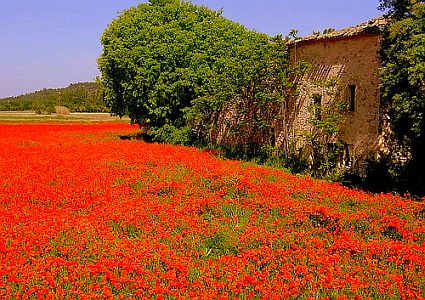 Boasting so many great sights, sounds and tastes, the only difficult part about deciding to take a trip to Provence could very well be deciding where to go and what to see. It is a sun-soaked region marked by azure Mediterranean waters and cobalt blue skies, fields of deep purple lavender, bright sunflowers, poppies, and olive and lemon trees, and was a famously favored region for impressionist painters like Van Gogh and Cézanne, who used the pervasive light and stunning palette of colors to paint their vivid landscapes.
Boasting so many great sights, sounds and tastes, the only difficult part about deciding to take a trip to Provence could very well be deciding where to go and what to see. It is a sun-soaked region marked by azure Mediterranean waters and cobalt blue skies, fields of deep purple lavender, bright sunflowers, poppies, and olive and lemon trees, and was a famously favored region for impressionist painters like Van Gogh and Cézanne, who used the pervasive light and stunning palette of colors to paint their vivid landscapes.
The Provençal countryside and port of Marseille characterized by author and filmmaker Marcel Pagnol still holds true today —old men gathered in town squares playing pétanque; people clinking glasses of pastis in the shade of café terraces; market stalls with the season’s bounty from local farms; fish coming straight from the boat to Marseille’s fish market; Roman ruins and medieval cobblestoned villages.
It is no wonder Provence is one of the most popular areas to visit in France. But unlike some places that may not live up to all the hype, Provence deserves all of the accolades it receives. Since you could potentially fill a lifetime with exploring this diverse and colorful region, here is my list of the top 10 things to do and see in Provence. Since narrowing this list down to just 10 things was hard enough, I couldn’t bear trying to put them in any kind of order.
 Marseille, being the second-largest city in France, is certainly not what many people picture when they envision quiet stone villages set among fields of lavender. It is big, gritty and rough’n’tumble, but don’t let its sometimes harsh exterior discourage you from making a visit.
Marseille, being the second-largest city in France, is certainly not what many people picture when they envision quiet stone villages set among fields of lavender. It is big, gritty and rough’n’tumble, but don’t let its sometimes harsh exterior discourage you from making a visit.
Visitors to Marseilles should not miss heading to the Vieux Port area of the city, where you will find market stalls filled Provençal products, Moroccan-like souks, and a centuries-old fish market with its wares coming straight off the boats behind it. In Vieux Port’s Le Panier neighborhood, you’ll find narrow, winding streets and authentic shops. You’ll also find pedestrianzed shopping streets such as Rue St-Feereol.
Make sure you stop somewhere and get a steamy bowl of bouillabaisse, a traditional fish stew containing different kinds of fish, shellfish and vegetables, flavored with a variety of herbs and spices such as garlic, orange peel, basil, bay leaf, fennel and saffron.
>>When planning your trip to Marseille, don’t forget to check out hotels in the Vieux Port.
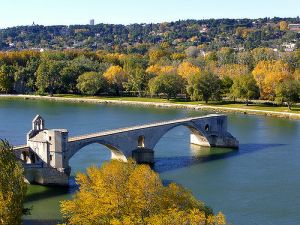 Avignon has long been one of my favorite cities in Provence. It has impressive and amazingly well preserved art and architecture, so it is not only picturesque, but also oozes history. The Papal Palace, which was home to several popes during the 14th century, boasts cavernous halls, beautiful grounds (picnic alert!) and is the largest Gothic palace in the world.
Avignon has long been one of my favorite cities in Provence. It has impressive and amazingly well preserved art and architecture, so it is not only picturesque, but also oozes history. The Papal Palace, which was home to several popes during the 14th century, boasts cavernous halls, beautiful grounds (picnic alert!) and is the largest Gothic palace in the world.
While Avignon is probably most noted for its famous bridge, Pont St. Benezet or the Pont d’Avignon, it is a vibrant city with an active student community, lots of history and makes for a great jumping off point for exploring the region.
>>Read about how to get from Paris to Avignon.
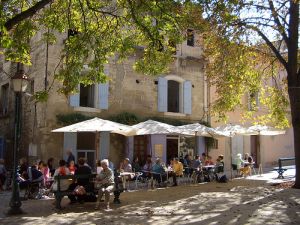 Located just 20 km south of Avignon, Saint Remy de Provence is a quaint, traditional Provençal village. Marked by Roman ruins (specifically the Triumphant Arch of Glanum), Saint Remy is a small, sleepy town with a whole lot of history. Not only was it once the site of a Roman city, it was also where Van Gogh was housed at the Monastery de Mausole when he was being treated (unsuccessfully) for his many psychiatric problems.
Located just 20 km south of Avignon, Saint Remy de Provence is a quaint, traditional Provençal village. Marked by Roman ruins (specifically the Triumphant Arch of Glanum), Saint Remy is a small, sleepy town with a whole lot of history. Not only was it once the site of a Roman city, it was also where Van Gogh was housed at the Monastery de Mausole when he was being treated (unsuccessfully) for his many psychiatric problems.
There is a beautiful town square in this usually sleepy town, which has a good selection of hotels, restaurants and shops. On Wednesdays, Saint Remy is home to a popular and bustling market. Stalls full of fresh produce (including melons grown in nearby Cavaillon), pottery and other Provençal goods fill the city. Though the atmosphere is lively and pleasant, if you’d prefer to avoid the crowds make sure you stay away from Saint Remy on Wednesdays in the high season.
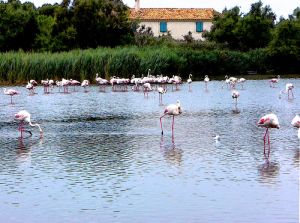 The bleached, desolate landscape of the Camargue wetlands stands in stark contrast to the usually brightly colored scenery of Provence, but it should not be missed by visitors headed to this area of Provence. The marshes, salt plains and rice fields in this protected region are roamed by wild white horses, black bulls and pink flamingos. The 780-sq-km area at the Rhone River delta was created over thousands of years by sediment flowing from the river to the Mediterranean. Today the area is home to over 500 species of migratory birds.
The bleached, desolate landscape of the Camargue wetlands stands in stark contrast to the usually brightly colored scenery of Provence, but it should not be missed by visitors headed to this area of Provence. The marshes, salt plains and rice fields in this protected region are roamed by wild white horses, black bulls and pink flamingos. The 780-sq-km area at the Rhone River delta was created over thousands of years by sediment flowing from the river to the Mediterranean. Today the area is home to over 500 species of migratory birds.
This unique area is great to explore by bike, jeep or horseback. Make sure you wear lots of bug repellent as the marshes attract lots of mosquitos. While some of the flamingos here hang out year ’round, visit in the spring, summer or fall before thousands migrate to Spain and Senegal in search of warmer temperatures.
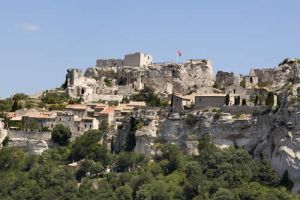 Although one of the most visited spots in France, Les Baux is well worth braving the potential crowds of other tourists. It’s located about 25 km south of Avignon just past the small town of Saint Remy de Provence, sitting precariously on a 245-meter high limestone baou (which means rocky spur in Provençal). The unique, spectacular village has been home to humans since 6,000 BCE, and during the Middle Ages was home to the most powerful feudal lords in southern France.
Although one of the most visited spots in France, Les Baux is well worth braving the potential crowds of other tourists. It’s located about 25 km south of Avignon just past the small town of Saint Remy de Provence, sitting precariously on a 245-meter high limestone baou (which means rocky spur in Provençal). The unique, spectacular village has been home to humans since 6,000 BCE, and during the Middle Ages was home to the most powerful feudal lords in southern France.
The dramatic rocks and cliffs overlooking a valley full of olive groves and vineyards have long inspired authors and artists, and is even said to be the inspiration for Dante Aligheri’s descriptions of Purgatory in the Inferno. It is a truly spectacular spot and shouldn’t be missed on a trip to Provence.
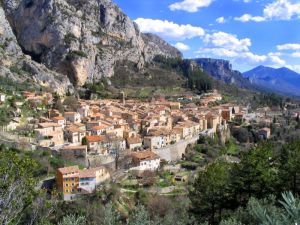 Also known as the Grand Canyon of Verdon, the plunging Gorges du Verdon is Europe’s deepest canyon, with oddly bright green waters flowing through the bottom. It’s 250m-750m deep and only 8m-90m wide. There is a great hike up this canyon, though not for those who have a fear of enclosed spaces. Also, bring a flashlight.
Also known as the Grand Canyon of Verdon, the plunging Gorges du Verdon is Europe’s deepest canyon, with oddly bright green waters flowing through the bottom. It’s 250m-750m deep and only 8m-90m wide. There is a great hike up this canyon, though not for those who have a fear of enclosed spaces. Also, bring a flashlight.
The drive to the beautiful Medieval town of Moustiers Sainte Marie is long and windy and can be very slow, but a visit to this charming village is well worth it and seems a million miles away from the 21st century.
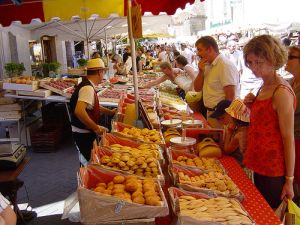 Often called the antiques capital of France, Isle sur la Sorgue sits on a winding set of canals and is home to the largest marché aux puces (flea market) in France outside of Paris.
Often called the antiques capital of France, Isle sur la Sorgue sits on a winding set of canals and is home to the largest marché aux puces (flea market) in France outside of Paris.
Isle sur la Sorgue also has a great Provençal market every Sunday and Thursday, with stalls overflowing with fresh walnuts and olives; men in aprons slicing hunks from giant wheels of cheese; brightly colored produce spilling out of bins; and baguettes leaving crusty crumbs on tables. It has long been one of my very favorite markets in France.
>>Read more about Markets Isle-sur-la-Sorgue
Need Market Shopping Tips?
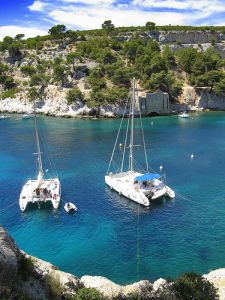 Although not nearly as famous as its nearby Riviera neighbor, Cassis is just as delightful as St. Tropez with an equally beautiful town and beach defined by white limestone cliffs and sheltered inlets called calanques. It also has a lovely, wide sandy beach perfect for getting your tan on in the summer (of course in the French tradition, sans bikini top).
Although not nearly as famous as its nearby Riviera neighbor, Cassis is just as delightful as St. Tropez with an equally beautiful town and beach defined by white limestone cliffs and sheltered inlets called calanques. It also has a lovely, wide sandy beach perfect for getting your tan on in the summer (of course in the French tradition, sans bikini top).
Cassis was an ancient fishing port and was rebuilt on the old ruins in the 18th century, resulting in a more regular layout than most other medieval villages. A walk through the old village streets will reveal well preserved old buildings, some dating back to the 16th century, and some restored with the colorful pastels of Provence. The picture-perfect harbor is dotted with masts and fishing boats. Although not an undiscovered beach town in France, Cassis tends to be less crowded than other Mediterranean cities and nearby Marseille.
>>Cassis is one of France’s Best Beaches
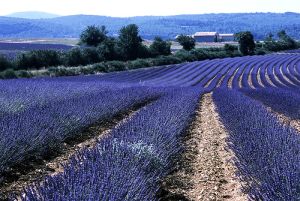 While Dignes is a great place simply to soak up the beauty of the natural surroundings—from fields of lavender to nearby mountains—it is also a great place to soak in the thermal pools. Dignes les Bains is named for the supposedly curative thermal springs located here. Wild and cultivated fields of lavender carpet the mountains and plains around Dignes, and the town celebrates the harvest of the fragrant purple plant every year during a five-day festival the first weekend in August.
While Dignes is a great place simply to soak up the beauty of the natural surroundings—from fields of lavender to nearby mountains—it is also a great place to soak in the thermal pools. Dignes les Bains is named for the supposedly curative thermal springs located here. Wild and cultivated fields of lavender carpet the mountains and plains around Dignes, and the town celebrates the harvest of the fragrant purple plant every year during a five-day festival the first weekend in August.
Located 2 km from Dignes center, you can soak in the thermal pools, cover yourself in mud and seaweed or soak in a lavender bath at the Etablissement Thermal. There is also a a great Provençal market in town on Wednesday Saturday mornings.
The best part of going to Dignes, however, very well could be getting there. The famous Train des Pignes (Pine Train) chugs along a narrow-gauge railway from Nice to Dignes. The train crosses through some of Provence’s most stunning mountain scenery, and is well worth a trip to Dignes les Bains.
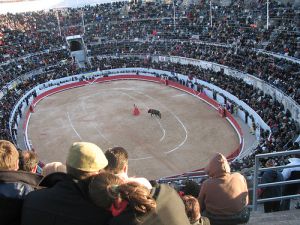 Although the narrow, winding streets, stone squares and colorful houses may look oddly familiar from many Van Gogh paintings, Arles’ historic roots date back far further than the days of the famous impressionist painter. Arles was the site of a Celtic settlement, a Greek colony and later a Roman city, so it is easy to imagine that this Provençal city is bursting at the seams with history and culture.
Although the narrow, winding streets, stone squares and colorful houses may look oddly familiar from many Van Gogh paintings, Arles’ historic roots date back far further than the days of the famous impressionist painter. Arles was the site of a Celtic settlement, a Greek colony and later a Roman city, so it is easy to imagine that this Provençal city is bursting at the seams with history and culture.
The city boasts a 20,000-seat Roman amphitheatre, which once hosted gruesome gladiator battles and now stages corrida (bullfighting), which sends the entire city into a fervor when the bull-fighting season begins each spring.
photo credits: provence, marseille , saint remy , camargue, moustiers sainte marie , sorgue market , cassis, lavender